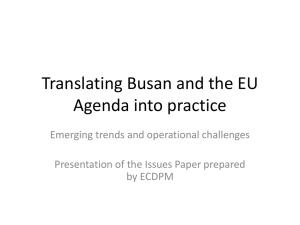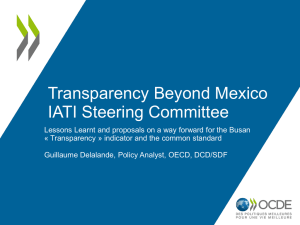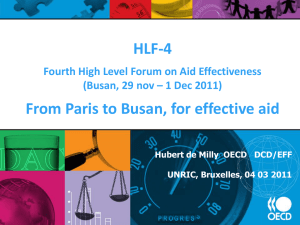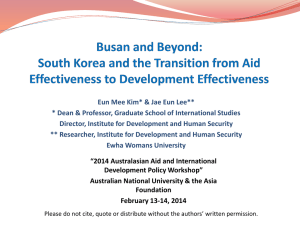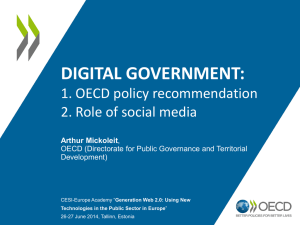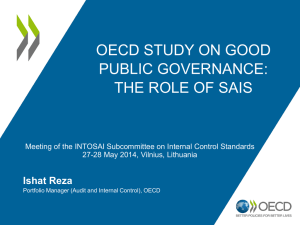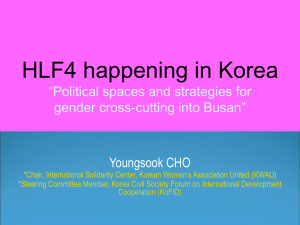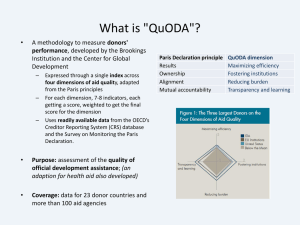Powerpoint
advertisement
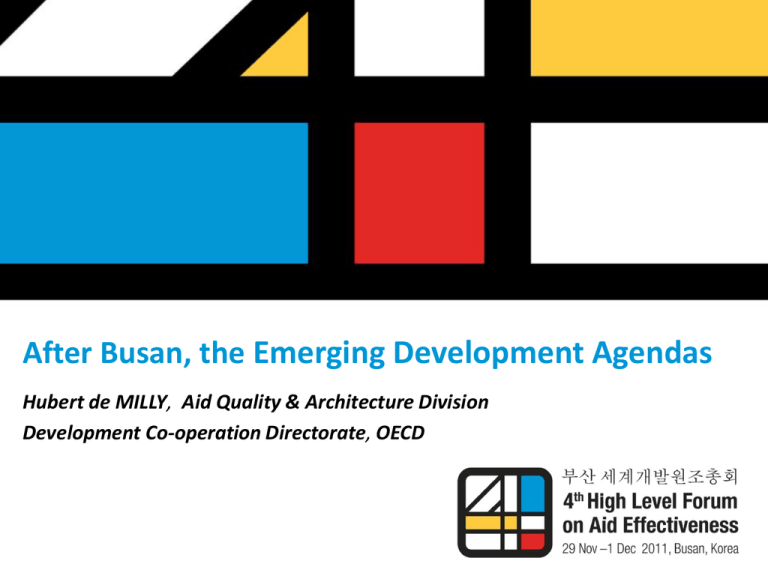
After Busan, the Emerging Development Agendas Hubert de MILLY, Aid Quality & Architecture Division Development Co-operation Directorate, OECD HLF-4: a turning point for international development co-operation • Conclusion of a 10-year process : Monterrey (2002), HLF-1 in Rome (2003), HLF-2 in Paris (2005), HLF-3 in Accra (2008), HLF-4 in Busan(2011). • First three HLF: transformed the way we do aid: Principles of local ownership, alignment, harmonisation, mutual accountability and management for development results. • HLF-4: seals a new global partnership for development, including more development sources – and not just aid. Builds on the support of diverse development actors. Outcome of the HLF-4 : The Busan “Global Partnership for Effective Development Co-operation” Broader and more inclusive than ever before • Includes donor countries, low-income and middle-income countries, emerging economies, civil society organisations, multilateral organisations, parliaments, the private sector, and climate finance institutions. • Re-endorses Paris: partners who signed up to Paris and Accra will intensify their efforts to implement their respective commitments in full (article 16). • “The principles, commitments and actions agreed in the outcome document in Busan shall be the reference for SouthSouth partners on a voluntary basis” (article 2). After the HLF-4: design and agree arrangements for the Busan “GP-EDC” by June 2012 Agree on: • “light working arrangements” for the Global Partnership on Effective Development Co-operation (art 36b) • global-level indicators and process for monitoring Busan agreement (art 35b) • institutional arrangements (with funding) for joint OECD-UNDP secretariat support to the Global Partnership (art 36d) After the HLF-4 : implement core Busan partnership commitments (thematic work) 1. Review plans to further untie aid (BP §18e) 2. Implement common, open standard for electronic publication of timely, comprehensive and forward-looking information (BP §23c) 3. Full implementation of AAA commitments on 3-5 year forward rolling plans (BP §24a) 4. Agree principles and guidelines to guide joint efforts in reducing the proliferation of multilateral / global fund and programme channels (BP §25b) 5. Agree on principles to address issue of countries that receive insufficient assistance (BP §25c) 6. Review delegation of authority to the field (all providers of development co-operation) (BP §25d) After Busan: implement the voluntary initiatives (Busan “building blocks”) 1. Implementation of the “Busan Action Plan for Statistics” 2. Implementation of the “Busan Joint Action Plan on Gender Equality and Development” 3. Following up on the “New Consensus on More Effective Institutions for Development” (building block) 4. Results and accountability building block 5. Transparency (both on development flows and domestic resources) building block 6. Building block on Managing Diversity and Reducing Fragmentation Voluntary initiatives (continued) 7. Building block on South-South and Triangular Cooperation 8. Implementation of the “New Deal for Engagement in Fragile States” 9. “Expanding and enhancing public and private cooperation for broad-based, inclusive and sustainable growth” building block 10. Efforts in the area of “Climate Change Finance and Development Effectiveness” The OECD Development Strategy 1. Why a Development Strategy? 2. What is OECD’s Comparative Advantage? 3. 3 levels and 4 areas of focus 4. The way forward 1. Why a DS? – The world has changed Annual world GDP (PPP) growth rate (3-year moving average) 1. Why a DS? More heterogeneity in the developing world 1990s 2000-2007 2. What can OECD offer developing countries? Example: Pre-tax vs. post-tax GINI differ more in the OECD area Inequality before taxes and transfers Inequality after taxes and transfers 60 50 40 30 20 10 OECD-24 avg. Peru Mexico Colombia Chile Brazil Argentina 0 2. OECD’s comparative advantage • Data collection, statistics. • A variety of tools and approaches (arm’s length diagnostics, multidisciplinary analysis peer reviews, policy reviews, standards and norms…) • Policy sharing and dialogue platforms (task teams, working parties, etc…). • Home of PD. Support coordination and effectiveness • Facilitating a space for developing countries to share knowledge and create a “network of influence” 3. A 3-level strategy to support development • Countries to develop own strategies: – facing domestic issues (e.g. greater income inequality, vulnerable middle class, rising expectations) – taking also into account sequencing and implementation • Shared challenges – clusters of countries whith common constraints ( e.g. natural resources or migration) • Global governance mechanisms have an equally important role 3. Four main areas of focus: I. Innovative and Sustainable Sources of Growth II. Mobilising Resources for Development III. Governance for Development IV. Measuring Progress Some emerging proposals….. Innovative and Sustainable Sources of Growth What the OECD is known for – what it can deliver 1. Policy support for individual countries Diagnostic phase to identify binding constraints (e.g. à la Going for Growth) Policy support phase --country/thematic reviews (e.g. à la innovation or entrepreneurship reviews) 2. Shared growth challenges – clusters of countries whith common growth constraints 3. Global outputs – expanding current outcomes to the global level e.g. Perspectives on Global Development (DEV), PISA (EDU) or global food security (TAD/DCD) Mobilising Resources: Emerging Proposals 1. 2. 3. The broad spectrum: domestic resources; investment; trade; aid etc. Whole of OECD approach needed in, for example: Policy Coherence Linking revenue to expenditure procedures and outcomes Application of OECD transfer pricing standards through effective exchange of information Best practice model on inter-agency collaboration on illicit flows New tools and instruments Launch a tax statistics database for developing countries and a tax incentives Transparency Framework Join Convention on Mutual Administrative Assistance in Tax Matters Flagship Publications Aid as a catalyst for mobilising other finance for development Focus on development financing in other flagship reports on Africa, South East Asia Governance 1. 2. 3. Country and Regional Level work Country/thematic reviews (e.g. governance reviews) based on country demand Linkages between regional dialogues and networks on Governance (AntiBribery Convention, OECD/AFDB Joint Initiative on Business Integrity) New tools and instruments Narrower set of indicators for measuring governance improvement in developing countries (public sector metrics) Policy guidance for improving governance (e.g. Policy Framework for Investment) with policy benchmarks Global Fora for Dialogue on Applicability of Tools and Instruments Strengthen Global Forum for Development to involve non-members in testing approaches and proposals on Governance Include non-members in the Public Governance Committee to shape good practices in addressing Governance challenges Measuring Progress 1. Better Policies for Better Lives – implications for the Development Strategy: 2. Measuring well-being - beyond GDP, to include equity, sustainability, satisfaction Looking beyond the MDGs/2015 towards global progress indicators Proposals 2. Measure what matters to people – extend the "How’s Life" framework Statistical systems capacity development – extend Paris 21 OECD global dialogue – strengthen links between statistics and policy 4. How is it progressing? • Inter-directorates working teams (until end of 2011) • Consultation with members and nonmembers through informal working group, existing committees, etc • The OECD Strategy on Development is being elaborated for endorsement at the 2012 MCM (May 2012) www.busanhlf4.org www.oecd.org/dac
